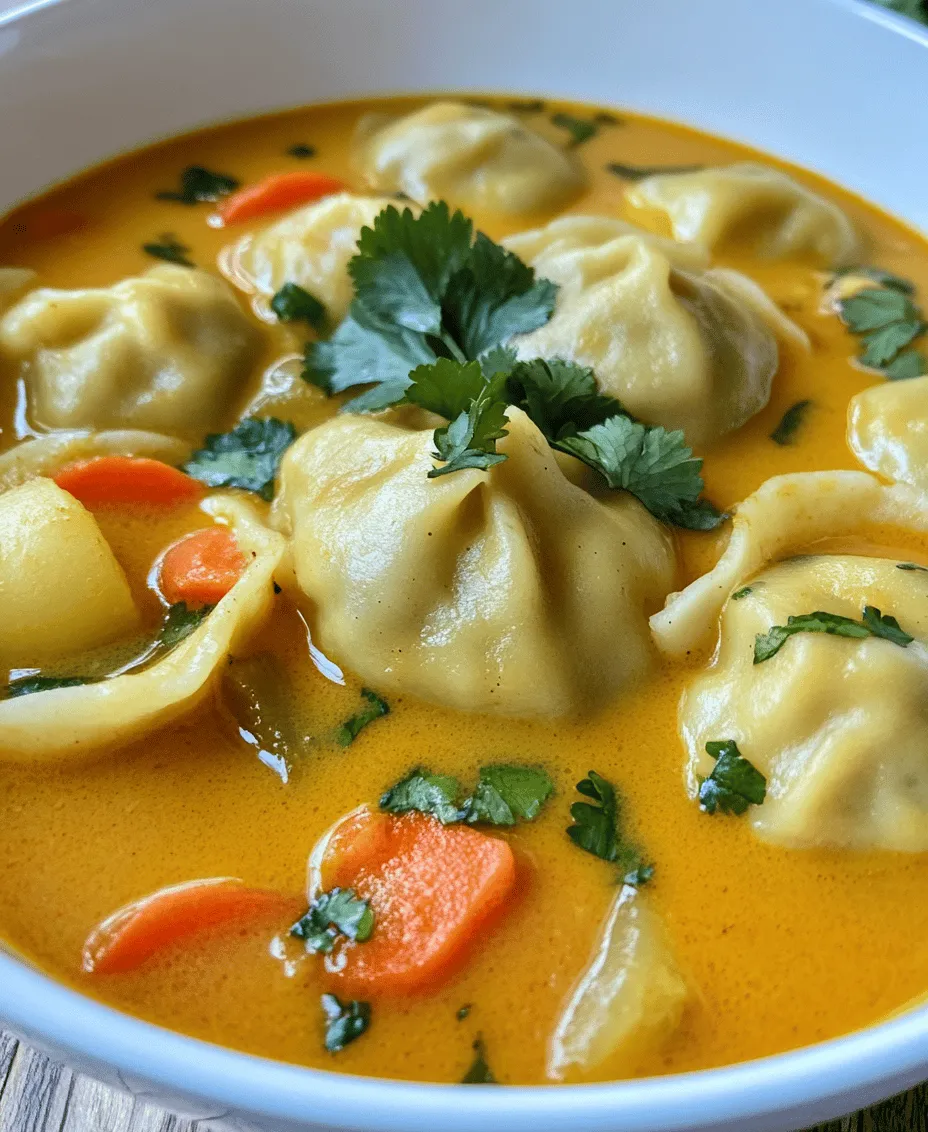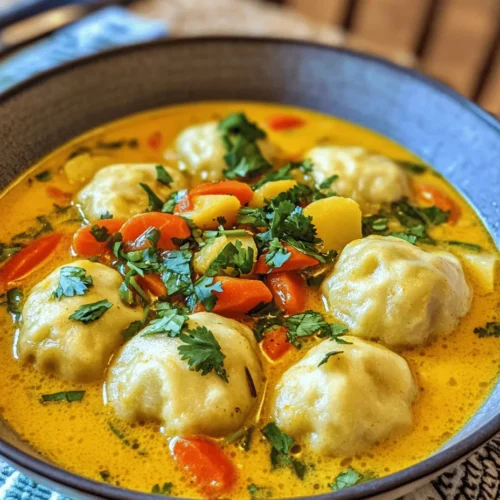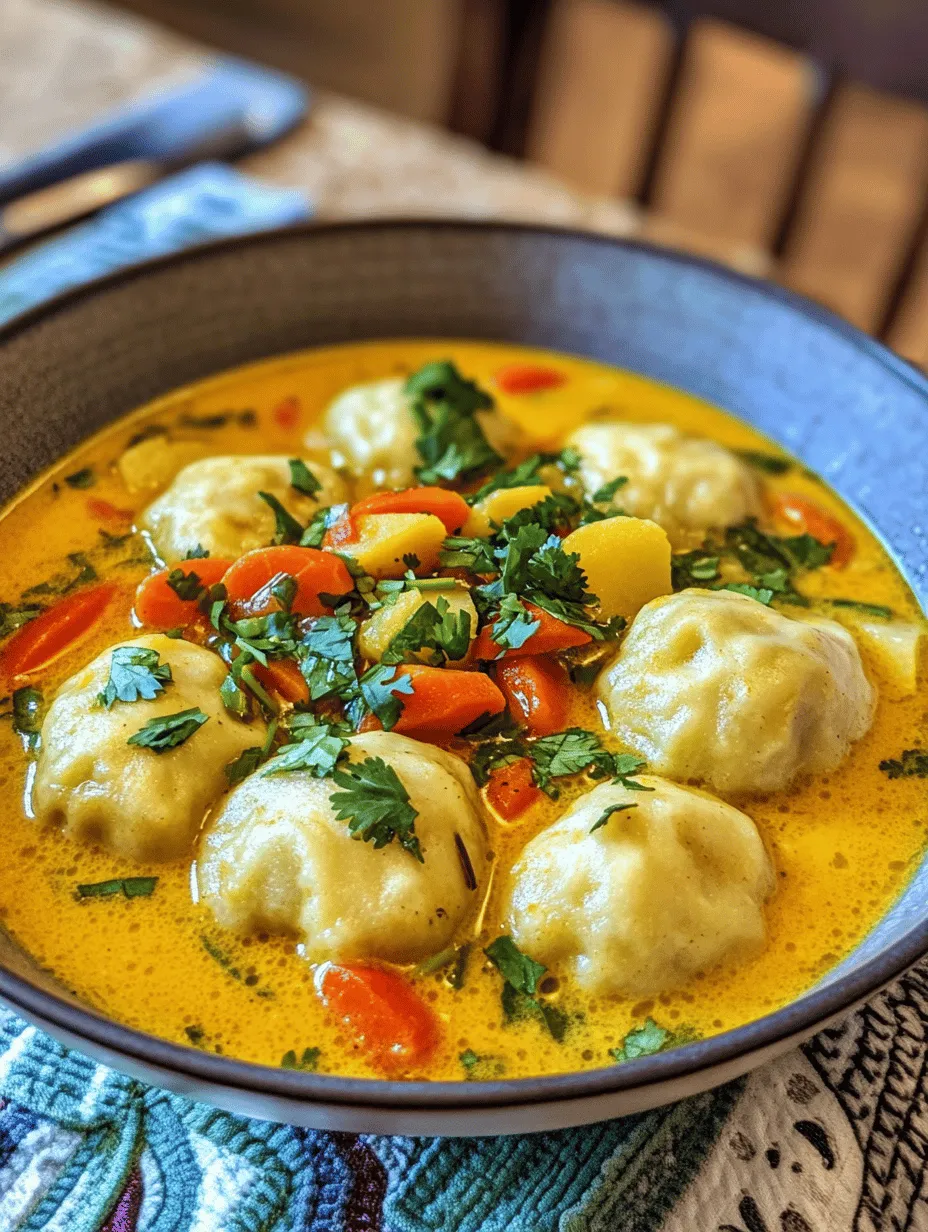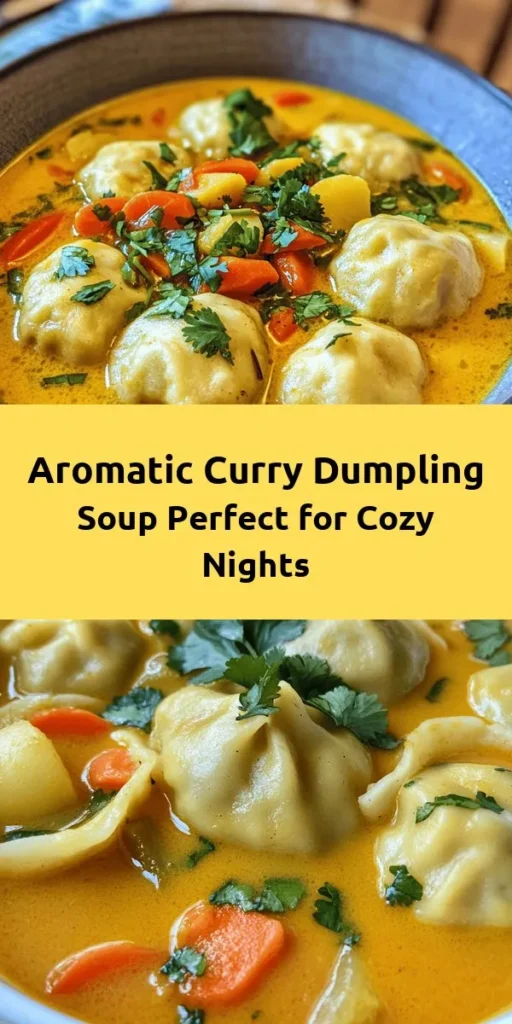Introduction
There’s something undeniably comforting about a warm bowl of soup, especially when coupled with tender dumplings. The combination of rich, savory broth and fluffy dumplings creates a dish that feels like a warm hug on a chilly day. Soup and dumplings are staples across countless cultures, each bringing its own unique twist to this beloved pairing. From the hearty chicken and dumplings of American cuisine to the delicate wonton soups found in Asian kitchens, the culinary world showcases endless variations that highlight the versatility and charm of these dishes.
In this recipe, we delve into the aromatic world of curry dumpling soup, a dish that marries the vibrant flavors of curry with the satisfying texture of dumplings. Curry, with its warm spices and complex flavor profiles, brings a depth to the soup that will tantalize your taste buds. This recipe is not just a feast for the senses, but also a healthful option, packed with fresh vegetables and creamy coconut milk, providing a nourishing meal that is as good for the soul as it is for the body.
As you embark on this culinary journey, expect a symphony of flavors that dance on your palate—from the earthy notes of turmeric and cumin to the sweetness of coconut milk and the freshness of vegetables. The best part? This curry dumpling soup is customizable, allowing you to adjust the ingredients and spice levels to suit your preferences. Whether you are looking to impress dinner guests or simply enjoy a cozy night in, this soup is sure to become a favorite.
Understanding Curry Dumpling Soup
The Essence of Curry
Curry is more than just a spice; it is a blend of various spices that have been used for centuries, primarily in South Asian and Southeast Asian cuisines. The origins of curry can be traced back to ancient India, where the word “kari” means sauce. Over time, this flavor-packed mixture has evolved, incorporating local ingredients and techniques, leading to the diverse array of curry powders and pastes we see today. Common spices found in curry blends include cumin, coriander, turmeric, and fenugreek, each contributing its own distinct flavor and health benefits.
Curry is renowned not only for its rich and complex taste but also for its numerous health advantages. Many of the spices used in curry are anti-inflammatory, antioxidant-rich, and have been shown to promote digestion and support overall health. Adding curry to your dishes not only elevates the flavor but also enhances their nutritional profile.
The Versatility of Dumplings
Dumplings, in their many forms, are a beloved food item worldwide. From the Chinese jiaozi to the Italian ravioli, dumplings encompass a variety of fillings and doughs that cater to different tastes and traditions. At their core, dumplings are made by encasing a filling—be it meat, vegetables, or cheese—within a dough, which can be steamed, boiled, or fried. This versatility makes dumplings a perfect addition to soups, as they absorb the flavors of the broth while providing a satisfying texture.
In this recipe, we will focus on creating dumplings that complement the curry soup perfectly, enhancing the overall dish while offering an array of flavors and textures. Additionally, dumplings can be made with a variety of flours, allowing for gluten-free or other dietary adaptations.
Nutritional Benefits of the Soup
The beauty of curry dumpling soup lies not only in its deliciousness but also in its healthful ingredients. The soup is typically packed with an array of fresh vegetables—such as carrots, bell peppers, and spinach—each contributing essential vitamins and minerals. These vegetables provide fiber, which aids in digestion and promotes a feeling of fullness.
Coconut milk is another star ingredient in this soup, adding creaminess and richness while being a dairy-free alternative. Rich in healthy fats, coconut milk can help promote heart health and provide a source of quick energy. Moreover, it is a great option for those with lactose intolerance or dairy allergies.
By combining the health benefits of fresh vegetables, the nourishing properties of coconut milk, and the anti-inflammatory benefits of curry spices, this soup is as wholesome as it is satisfying.
Ingredients Breakdown
Dumpling Ingredients
To create the perfect dumplings for your curry soup, you will need the following ingredients:
– All-Purpose Flour: The foundation of your dumpling dough. All-purpose flour provides the necessary structure and chewiness. You can also experiment with whole wheat or gluten-free flour for different textures.
– Salt: A key flavor enhancer that helps to bring out the taste of the dumplings.
– Water: Used to hydrate the flour and bind the ingredients together. The temperature of the water can affect the dough consistency, with warm water often yielding a softer dough.
– Egg (optional): Adding an egg to the dough can enrich its flavor and improve its elasticity, resulting in a tender dumpling.
The dumpling filling can vary widely based on your preferences. Common fillings include minced meat (such as pork or chicken), chopped vegetables, or a combination of both. You can also include herbs and spices to further enhance the flavor profile.
Soup Ingredients
For the soup itself, gather the following ingredients to ensure a nourishing and flavorful broth:
– Vegetable Broth: Base of the soup that adds depth and richness. You can use store-bought or homemade vegetable broth depending on your preference.
– Fresh Vegetables: Choose a colorful mix of vegetables such as carrots, bell peppers, bok choy, and green onions. These not only add flavor but also increase the nutritional value of the soup.
– Curry Powder or Paste: The star ingredient that brings warmth and intensity to the soup. Depending on your heat tolerance, you can choose mild or spicy curry blends.
– Coconut Milk: Adds creaminess and a hint of sweetness that balances the spices in the soup.
– Fresh Herbs: Optional garnishes such as cilantro or basil can add freshness and a pop of color to your dish.
The combination of fresh vegetables, rich broth, aromatic spices, and creamy coconut milk creates a soup that is not only delicious but also packed with nutrients.
Step-by-Step Instructions for Preparing the Dumplings
Making the Dumpling Dough
1. Mix the Dry Ingredients: In a large mixing bowl, combine the all-purpose flour and salt. Stir to ensure the salt is evenly distributed throughout the flour.
2. Add the Water: Gradually add warm water to the flour mixture, stirring with a fork or your hands until a shaggy dough begins to form. If you are using an egg, beat it separately and incorporate it with the water.
3. Knead the Dough: Transfer the dough onto a lightly floured surface. Knead the dough for about 5-7 minutes until it becomes smooth and elastic. The dough should be neither too sticky nor too dry; adjust the water or flour as necessary to achieve the right consistency.
4. Rest the Dough: Once the dough is kneaded, cover it with a damp cloth or plastic wrap and allow it to rest for at least 30 minutes. This resting period relaxes the gluten, making it easier to roll out the dough later.
Preparing the Filling
While the dough is resting, you can prepare the filling for your dumplings:
1. Choose Your Ingredients: Select your preferred protein and vegetable combination. For example, you might opt for ground chicken mixed with finely chopped cabbage and green onions.
2. Season the Filling: In a bowl, combine the filling ingredients with spices and herbs of your choice. Common additions include garlic, ginger, soy sauce, and sesame oil for an Asian-inspired flavor, or cumin and coriander for a more curry-focused filling.
3. Mix Thoroughly: Ensure that all ingredients are well combined, allowing the flavors to meld together. Taste the mixture and adjust the seasoning as necessary.
Shaping and Cooking the Dumplings
1. Roll Out the Dough: After resting, divide the dough into smaller sections and roll each section out into a thin sheet on a floured surface. Aim for about 1/8 inch in thickness.
2. Cut Out Circles: Use a round cutter or a glass to cut out circles from the rolled dough. The size can vary depending on how big you want your dumplings to be, but a diameter of about 3 inches is common.
3. Fill the Dumplings: Place a small spoonful of filling in the center of each dough circle. Be careful not to overfill, as this can make sealing the dumplings difficult.
4. Seal the Dumplings: Moisten the edges of the dough with water, fold the circle in half, and pinch the edges together firmly to seal. You can create pleats along the edges for a decorative touch, ensuring that the dumpling is well sealed to prevent any filling from escaping during cooking.
5. Cook the Dumplings: Dumplings can be cooked by boiling, steaming, or pan-frying. If you prefer boiled dumplings, bring a pot of salted water to a gentle boil and add the dumplings, cooking until they float to the surface—approximately 4-5 minutes. For steamed dumplings, place them in a steamer basket lined with parchment paper and steam for about 10 minutes.
As you complete these initial steps, you will have laid the foundation for a delicious curry dumpling soup that is sure to impress. The next phase will involve bringing together the soup components and creating a harmonious dish that showcases your dumplings in a fragrant curry broth. Stay tuned for the continuation of this delightful recipe!

Cooking Methods: Boiling vs. Steaming
When preparing curry dumplings, the method of cooking can significantly influence both texture and flavor. The two most common techniques are boiling and steaming, each offering unique benefits.
Boiling: This method is straightforward and quick. When dumplings are boiled, they absorb some of the broth’s flavors as they cook, resulting in a heartier taste. However, it’s essential to ensure that the dumplings are not overcooked, as this can lead to a mushy texture. Boiling is perfect when you want the dumplings to meld seamlessly with the soup.
Steaming: Steaming, on the other hand, preserves the integrity of the dumplings, keeping them plump and preventing them from becoming waterlogged. This method allows the dumplings to maintain their shape and texture, perfect for those who prefer a firmer bite. Additionally, steaming can enhance the flavors of the dumpling filling without diluting them in the broth.
Choosing between boiling and steaming ultimately depends on your texture preference and the desired outcome for your curry dumpling soup.
Crafting the Soup Base
Creating a robust soup base is essential for the flavor profile of your curry dumpling soup. Here’s how to construct a deliciously aromatic foundation.
Sautéing Aromatics
Start by heating a tablespoon of oil in a large pot over medium heat. Once the oil is shimmering, add finely chopped onions and sauté them until they are translucent and just beginning to brown. This process can take about 5-7 minutes. The caramelization of onions adds a sweet depth to the soup.
Next, add minced garlic and ginger—two key ingredients that will elevate the aromatic base. Sauté for an additional minute until fragrant, making sure not to let the garlic burn. Properly sautéed onions and garlic create a flavorful base that enhances every spoonful of your soup.
Incorporating Vegetables and Spices
After the aromatics have softened, it’s time to layer in your vegetables. Common choices include diced carrots, bell peppers, and mushrooms, which add texture and nutrition. Stir these in for a few minutes until they start to soften.
Now, it’s time to introduce your spices. A blend of curry powder, turmeric, cumin, and coriander will provide warmth and complexity. Toast the spices in the pot for about a minute; this releases their essential oils, maximizing their flavor impact. The combination of sautéed vegetables and spices creates a fragrant base from which the soup will develop.
Building the Broth
With the aromatic base ready, it’s crucial to build a flavorful broth. Pour in vegetable or chicken stock, depending on your preference. The broth is the soul of your soup; it must be rich and well-seasoned. Bring the mixture to a gentle simmer.
The simmering process is vital for optimal flavor extraction. Allow the broth to simmer for at least 15-20 minutes, stirring occasionally. This helps the flavors meld together and ensures that the spices fully infuse the liquid. Taste the broth periodically, and adjust seasoning with salt and pepper as needed.
Combining Dumplings and Soup
Once your broth is prepared, it’s time to add the dumplings. If you’ve opted for boiling, gently drop the dumplings into the simmering broth. Be careful not to overcrowd the pot; you want to allow enough space for the dumplings to cook evenly.
If you’re using steamed dumplings, consider transferring your broth to a steamer pot. Place the dumplings on a steaming tray above the simmering broth. This method retains the dumpling’s shape and flavor while allowing the steam to infuse into the broth below.
After adding the dumplings, let the soup simmer for another 5-10 minutes. This allows the dumplings to cook through, and the flavors to meld beautifully. Keep an eye on the dumplings; they should float to the surface when they’re done.
Finishing Touches for the Perfect Curry Dumpling Soup
To elevate the flavor of your soup, a splash of lime juice is a game-changer. The acidity balances the richness of the curry and adds brightness. Squeeze in the juice of half a lime just before serving, stirring it gently into the soup.
Fresh herbs are also essential for garnishing. Chopped cilantro or green onions sprinkled on top not only enhances the visual appeal but also adds a fresh, aromatic element. The bright green herbs contrast beautifully with the golden hues of the soup, making it inviting.
Serving Suggestions
When it comes to serving curry dumpling soup, presentation plays a crucial role. Here are a few ideas to enhance the visual appeal and overall experience:
– Accompaniments: Serve the soup alongside crusty bread or steamed jasmine rice to soak up the delicious broth. A light salad with citrus dressing can provide a refreshing contrast.
– Garnishing: Use a drizzle of coconut milk or a dollop of yogurt for a creamy finish. Serve slices of lime on the side, allowing guests to add more if they desire.
– Beverage Pairings: A chilled glass of white wine or herbal iced tea complements the spices beautifully. For a non-alcoholic option, consider serving a refreshing sparkling water with lime.
Health Benefits of Curry Dumpling Soup
Curry dumpling soup is not only comforting but also packs a nutritional punch. Here’s a breakdown of some key ingredients and their health benefits:
– Vegetables: Carrots, bell peppers, and mushrooms are rich in vitamins and antioxidants, supporting overall health and well-being.
– Ginger and Garlic: Both ingredients have anti-inflammatory properties and are known to boost the immune system.
– Curry Spices: Turmeric, a primary component of curry powder, contains curcumin, which has anti-inflammatory and antioxidant benefits.
– Dumpling Filling: If using lean proteins or plant-based options, you’re adding essential amino acids to your diet.
Incorporating this soup into a balanced diet can provide nourishment while satisfying your cravings for flavorful comfort food.
Conclusion
Curry dumpling soup is a delightful dish that encapsulates comfort and flavor in every bowl. The combination of tender dumplings filled with savory ingredients and a richly spiced broth creates a harmonious experience that’s hard to resist. The layers of flavor—from the sautéed aromatics to the fresh herbs—make each spoonful an adventure.
Encouraging experimentation with different vegetables, proteins, or spices can lead to exciting variations of this recipe, making it a versatile favorite in your household. As you embark on this culinary journey, remember to enjoy the process of cooking and savor the final dish. Whether it’s a cozy dinner or a gathering with friends, curry dumpling soup is sure to warm hearts and appetites alike.



